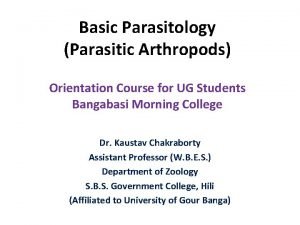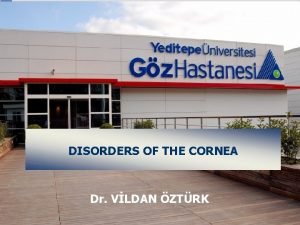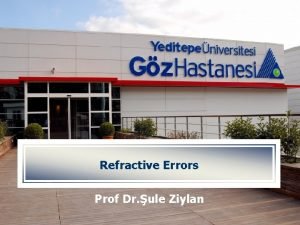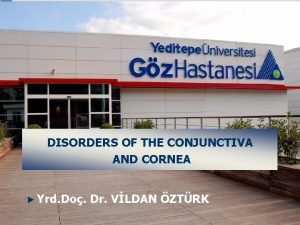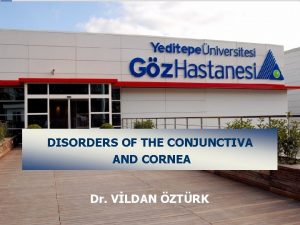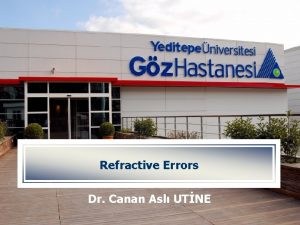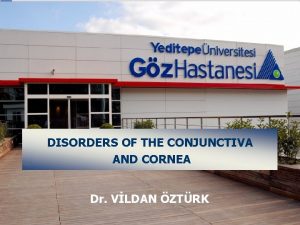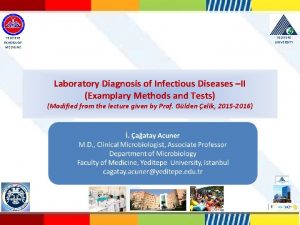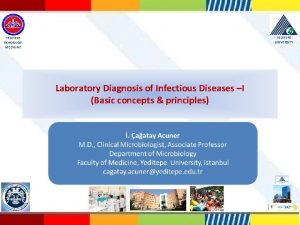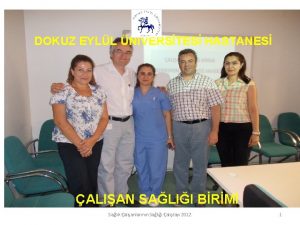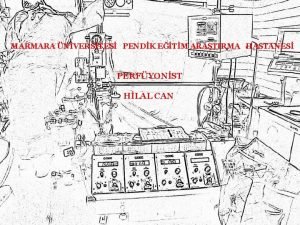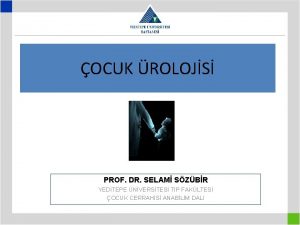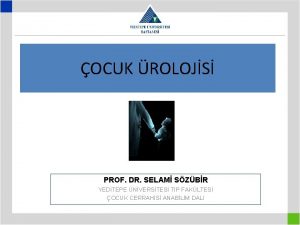YEDTEPE NVERSTES GZ HASTANES Diseases of the Eyelids



















































- Slides: 51

YEDİTEPE ÜNİVERSİTESİ GÖZ HASTANESİ Diseases of the Eyelids and Orbita Prof. Dr. Raciha Beril Küçümen Yeditepe University Department of Ophthalmology 2016 -2017 Educational Year

YEDİTEPE ÜNİVERSİTESİ GÖZ HASTANESİ Benign Lesions of the Eyelids Chalazion Caused by blockage of meibomian gland orifices Stagnation of sebaceous secretions causes a chronic inflammation

YEDİTEPE ÜNİVERSİTESİ GÖZ HASTANESİ Benign Lesions of the Eyelids Chalazion ü Painless, round and firm lesion in the tarsal plate ü Initial conservative treatment with warm compresses ü Surgery for large persistent lesions causing astigmatism or cosmetically unacceptable

YEDİTEPE ÜNİVERSİTESİ GÖZ HASTANESİ Benign Lesions of the Eyelids Hordeolum (Stye) Acute Staphylococcal infection of a lash follicle Tender inflamed swelling in the lid margin pointing anteriorly Warm compresses and antibiotic ointments In severe cases there may be preseptal cellulitis necessitating oral antibiotics

YEDİTEPE ÜNİVERSİTESİ GÖZ HASTANESİ Benign Eyelid Lesions Xanthelasma Commonly over medial canthal areas Lipid laden macrophages accumulate in dermal tissues Sometimes associated with disorders of lipid metabolism Surgical excision for cosmetic reasons

YEDİTEPE ÜNİVERSİTESİ GÖZ HASTANESİ Malpositions of the Eyelids Entropion Inversion of the eyelid

YEDİTEPE ÜNİVERSİTESİ GÖZ HASTANESİ epiblepharon

YEDİTEPE ÜNİVERSİTESİ GÖZ HASTANESİ Malpositions of the Eyelids Entropion 4 main types Involutional (senile) Cicatricial Congenital Spastic Treatment is surgical

YEDİTEPE ÜNİVERSİTESİ GÖZ HASTANESİ Malpositions of the Eyelids Ectropion Outward turning of the eyelid 4 main types Involutional (senile) Cicatricial Congenital Paralytic Treatment is surgical

YEDİTEPE ÜNİVERSİTESİ GÖZ HASTANESİ Malpositions of the Eyelids Ptosis

YEDİTEPE ÜNİVERSİTESİ GÖZ HASTANESİ Malpositions of the Eyelids Ptosis ü Drooping of the upper eyelid ü 4 main types according to etiology Myogenic due to congenital or acquired myopathy (e. g. myasthenia) Aponeurotic due to dehiscence of levator aponeurosis (senile, trauma, surgery) Neurogenic due to innervational deficit (e. g. third nerve palsy, Horner`s syndrome, Marcus Gunn Jawwinking) Mechanical ptosis due to mass or scarring

YEDİTEPE ÜNİVERSİTESİ GÖZ HASTANESİ

YEDİTEPE ÜNİVERSİTESİ GÖZ HASTANESİ

YEDİTEPE ÜNİVERSİTESİ GÖZ HASTANESİ Malpositions of the Eyelids Ptosis Mechanical due to tumor on the eyelid ü Treatment is surgical ü Surgery as soon as possible if congenital ptosis is obscuring the visual axis

YEDİTEPE ÜNİVERSİTESİ GÖZ HASTANESİ Disorders of the Eyelashes

YEDİTEPE ÜNİVERSİTESİ GÖZ HASTANESİ Disorders of the Eyelashes Trichiasis ü Acquired posterior misdirection of previously normal eyelashes ü Caused by chronic inflammation of the eyelids in trachoma or ü chronic blepharitis Causes corneal irritation, ulceration Distichiasis ü A second row of eyelashes growing behind the normal eyelash-line ü Congenital condition ü Acquired

YEDİTEPE ÜNİVERSİTESİ GÖZ HASTANESİ Tumors of the Eyelids Signs Suggesting Malignancy Slow painless growth Ulceration, bleeding, crusting İrregular pigmentary changes Distortion of the eyelid margin architecture Telangiectasias Loss of cilia

YEDİTEPE ÜNİVERSİTESİ GÖZ HASTANESİ Tumors of the Eyelids Basal Cell Carcinoma ü ü Most common human malignancy 10% involve the eyelids Mostly arises on the lower lid Slow growing, locally invasive, nonmetastasizing ü Treatment with surgical excision followed by reconstruction

YEDİTEPE ÜNİVERSİTESİ GÖZ HASTANESİ Tumors of the Eyelids Squamous Cell Carcinoma

YEDİTEPE ÜNİVERSİTESİ GÖZ HASTANESİ Tumors of the Eyelids Squamous Cell Carcinoma ü 5 -10% of eyelid malignancies ü Mostly on lower lid ü May arise de novo or from precancerous dermatosis ü Fair complexion and chronic sun exposure ü Has potential to metastasize to regional lymph nodes

YEDİTEPE ÜNİVERSİTESİ GÖZ HASTANESİ Tumors of the Eyelids Sebaceous Gland Carcinoma Malignant Melanoma

YEDİTEPE ÜNİVERSİTESİ GÖZ HASTANESİ Tumors of the Eyelids Sebaceous Gland Carcinoma ü Arises from sebaceous glands ü Metastasize to regional nodes, lungs, liver or brain ü 10% mortality rate Malignant Melanoma ü Rare but potentially lethal

YEDİTEPE ÜNİVERSİTESİ GÖZ HASTANESİ Disorders of the Orbit Thyroid Orbitopathy ü Seen in ~ 30% of patients with Grave’s disease ü 90% of orbitopathy cases seen in Grave`s disease, rarely in hypothyroidism or in euthyroid patients ü Orbital tissue changes caused by autoimmune stimuli can be seen before, simultaneously or after hormonal thyroid disease ü Severity varies greatly from very mild changes to blindness ü Initial inflammatory stage with active changes ends in 2 -3 years followed by quiescent stage ü Incidence and severity of orbitopathy is higher in smokers

YEDİTEPE ÜNİVERSİTESİ GÖZ HASTANESİ Disorders of the Orbit Thyroid Orbitopathy

YEDİTEPE ÜNİVERSİTESİ GÖZ HASTANESİ Disorders of the Orbit Thyroid Orbitopathy

YEDİTEPE ÜNİVERSİTESİ GÖZ HASTANESİ Disorders of the Orbit Thyroid Orbitopathy Clinical Signs ü Eyelid retraction (also lid-lag and frightened appearance) ü Proptosis (most common cause of proptosis in adults) ü Restrictive myopathy (muscle fibrosis causes restricted ocular motility hence diplopia) ü Soft tissue involvement ü Lagophtalmos and dry eyes ü Compressive optic neuropathy (compression of the optic nerve at the orbital apex by enlarged muscles may require emergency treatment with steroids, radiation or surgical decompression)

YEDİTEPE ÜNİVERSİTESİ GÖZ HASTANESİ Disorders of the Orbit Thyroid Orbitopathy Treatment In active inflammatory disease ü Supportive treatment (artificial tears) and regular follow-up ü Emergency eyelid surgery if corneal problems threaten vision ü Steroids, radiotherapy or emergency orbital decompression surgery if compressive optic neuropathy present In inactive disease ü Strabismus surgery for diplopia ü Eyelid surgery to repair lid retraction

YEDİTEPE ÜNİVERSİTESİ GÖZ HASTANESİ Infections of the Orbit Preseptal Cellulitis ü Bacterial infection of the soft tissues anterior to the orbital septum

YEDİTEPE ÜNİVERSİTESİ GÖZ HASTANESİ Infections of the Orbit Preseptal Cellulitis Symptoms & Signs ü Periorbital swelling and tenderness ü Normal ocular motility Treatment ü Oral antibiotics

YEDİTEPE ÜNİVERSİTESİ GÖZ HASTANESİ Infections of the Orbital Cellulitis ü Bacterial or fungal infection of the soft tissues behind the orbital septum Etiology ü Spread of infections to orbita from adjacent structures (sinusitis, dacryocystitis or facial infection) ü Following injuries penetrating orbital septum or eye surgery

YEDİTEPE ÜNİVERSİTESİ GÖZ HASTANESİ Infections of the Orbital Cellulitis Symptoms &Signs Proptosis and painful eye movements with diplopia Optic nerve dysfunction Ocular Complications: central retinal artery or vein occlusion , endophthalmitis , optic neuropathy,

YEDİTEPE ÜNİVERSİTESİ GÖZ HASTANESİ Infections of the Orbital Cellulitis Work-up ü White cell count ü CT of the orbit & brain (to rule out complications) Complications ü Intracranial spread ( meningitis, cavernous sinus thrombosis) ü Abscess formation ( orbital, subperiosteal, brain)

YEDİTEPE ÜNİVERSİTESİ GÖZ HASTANESİ Infections of the Orbital Cellulitis Treatment ü Parenteral broad spectrum antibiotics (polymicrobial infection) in the hospital ü Surgical drainage of the orbital or subperiosteal abscess may be needed

YEDİTEPE ÜNİVERSİTESİ GÖZ HASTANESİ Inflammations of the Orbit Idioptahic Orbital Inflammatory Disease - IOID Orbital Pseudotumor ü Idiopathic, non-specific inflammation involving an or all of the soft tissue components of the orbit ü Myositis ü Dacryoadenitis ü Scleritis ü Optic perineuritis ü ü Symptoms & Signs Painful proptosis Lid edema and conjuntival inflammation Limitation of ocular motility May mimic orbital cellulitis

YEDİTEPE ÜNİVERSİTESİ GÖZ HASTANESİ Inflammations of the Orbital Pseudotumor Treatment ü ü Biopsy NSAIDs and Steroids Radiotherapy if unresponsive to steroids Immunosupressives for resistant cases

YEDİTEPE ÜNİVERSİTESİ GÖZ HASTANESİ Inflammations of the Orbital Myositis ü Idiopathic orbital inflammation only involves one or more extraocular muscles Tolosa-Hunt syndrome ü Non-specific granulomatous inflammation of the cavernous sinus ü Periorbital pain, proptosis and cranial nerve palsies ü Systemic steroids

YEDİTEPE ÜNİVERSİTESİ GÖZ HASTANESİ Tumors of the Orbit Classification ü ü ü ü Vascular Lacrimal gland Lymphoproliferative Cystic Neural Rhabdomyosarcoma Metastatic or invasion from adjacent structures

YEDİTEPE ÜNİVERSİTESİ GÖZ HASTANESİ Tumors of the Orbit Vascular Tumors ü Capillary Hemangioma Ø Most common orbital and periorbital tumor in children Ø Periocular swelling may increase in size during crying Ø Tumor grows during the first year of life then starts to regress Ø In 75 % of cases complete resolution seen by age 7 Ø Intralesional steroid injection, systemic steroids, systemic betablockers or surgical resection if tumor causes visual impairment

YEDİTEPE ÜNİVERSİTESİ GÖZ HASTANESİ Tumors of the Orbit Capillary Hemangioma

YEDİTEPE ÜNİVERSİTESİ GÖZ HASTANESİ Tumors of the Orbit Vascular Tumors ü Cavernous Hemangioma Ø Most common benign orbital tumor in adults Ø Causes slowly progressive proptosis Ø Surgical resection ü Lymphangioma ü Orbital varices

YEDİTEPE ÜNİVERSİTESİ GÖZ HASTANESİ Tumors of the Orbit Lacrimal Gland Tumors Pleomorphic adenoma (Benign mixed cell tumor) ü Most common epithelial tumor ü Treatment requires surgical excision ü Incomplete excision may lead to malignant transformation Malignant lacrimal gland tumors ü Pleomorphic adenocarcinoma ü Adenoid cystic carcinoma ü Mucoepidermoid carcinoma Malignant tumors require radical surgical treatment with orbital exenteration followed by radiotherapy

YEDİTEPE ÜNİVERSİTESİ GÖZ HASTANESİ Tumors of the Orbit Lymphoproliferative Disorders ü May involve any part of the orbit but sometimes confined to ü conjunctiva or lacrimal gland Systemic investigation needed to rule out systemic disease Treatment ü Radiotherapy for local disease ü Chemotherapy for systemic disease

YEDİTEPE ÜNİVERSİTESİ GÖZ HASTANESİ Tumors of the Orbit Rhabdomyosarcoma ü ü ü ü Most common primary malignant orbital tumor in children Presents with rapidly progressive proptosis Examination shows orbital mass CT shows poorly defined mass of homogenous density often with bony destruction Diagnosis requires biopsy Systemic work-up needed to rule out metastasis Treatment by high dose local radiotherapy followed by chemotherapy 90% survival when tumor is confined to the orbit

YEDİTEPE ÜNİVERSİTESİ GÖZ HASTANESİ Tumors of the Orbit Cystic Lesions Dermoid Cyst ü Benign cystic teratoma with a fibrous wall which contains dermal appendages ü Superficial dermoid cysts present in infancy as an upper temporal or upper nasal round lesion ü Deep dermoids present later in life ü Treatment with surgical excision Mucocele ü Arises in the sinuses and invades the orbita after eroding the orbital walls Blood cyst ü Rare, may be associated with blunt trauma or vascular lesions of the orbit

YEDİTEPE ÜNİVERSİTESİ GÖZ HASTANESİ Tumors of the Orbit Dermoid Cyst

YEDİTEPE ÜNİVERSİTESİ GÖZ HASTANESİ Tumors of the Orbit Neural Tumors Optic Nerve Glioma ü Slow growing tumor ü May be associated with Neurofibromatosis type I ü Fusiform enlargement of the optic nerve ü Observation if vision is good ü Surgical excision if vision is poor and proptosis is prominent Optic Nerve Sheath Meningioma ü Arises from the meningeal covering of the optic nerve ü Causes slowly progressive visual loss

YEDİTEPE ÜNİVERSİTESİ GÖZ HASTANESİ Tumors of the Orbit Metastatic In children ü Neuroblastoma, Ewing`s sarcoma, Acute Myeloid Leukemia In Adults ü Breast carcinoma, Lung carcinoma, Prostate carcinoma Treatment is radiotherapy and chemotherapy Tumor invasion from adjacent structures ü Maxillary sinus ca, Ethmoidal sinus ca, Nasopharyngeal ca

YEDİTEPE ÜNİVERSİTESİ GÖZ HASTANESİ Blow-out Fractures of the Orbit ü Caused by sudden increase in the orbital pressure ü Most frequently orbital floor is fractured

YEDİTEPE ÜNİVERSİTESİ GÖZ HASTANESİ Blow-out Fractures of the Orbit

YEDİTEPE ÜNİVERSİTESİ GÖZ HASTANESİ Blow-out Fractures of the Orbit ü ü Symptoms & Signs Periocular ecchymosis and edema Enophthalmos Infraorbital nerve anesthesia Diplopia (entrapment of the orbital tissues) ü ü Work-up CT Hess test ü ü Treatment Conservative treatment with antibiotics initially If diplopia persists surgical repair is done

YEDİTEPE ÜNİVERSİTESİ GÖZ HASTANESİ The End
 Why do camels humps flop over
Why do camels humps flop over Hổ sinh sản vào mùa nào
Hổ sinh sản vào mùa nào đại từ thay thế
đại từ thay thế Diễn thế sinh thái là
Diễn thế sinh thái là Vẽ hình chiếu vuông góc của vật thể sau
Vẽ hình chiếu vuông góc của vật thể sau Công thức tính thế năng
Công thức tính thế năng Thế nào là mạng điện lắp đặt kiểu nổi
Thế nào là mạng điện lắp đặt kiểu nổi Tỉ lệ cơ thể trẻ em
Tỉ lệ cơ thể trẻ em Lời thề hippocrates
Lời thề hippocrates Vẽ hình chiếu đứng bằng cạnh của vật thể
Vẽ hình chiếu đứng bằng cạnh của vật thể Quá trình desamine hóa có thể tạo ra
Quá trình desamine hóa có thể tạo ra Môn thể thao bắt đầu bằng chữ đua
Môn thể thao bắt đầu bằng chữ đua Hát kết hợp bộ gõ cơ thể
Hát kết hợp bộ gõ cơ thể Khi nào hổ mẹ dạy hổ con săn mồi
Khi nào hổ mẹ dạy hổ con săn mồi điện thế nghỉ
điện thế nghỉ Dot
Dot Thế nào là sự mỏi cơ
Thế nào là sự mỏi cơ độ dài liên kết
độ dài liên kết Trời xanh đây là của chúng ta thể thơ
Trời xanh đây là của chúng ta thể thơ Gấu đi như thế nào
Gấu đi như thế nào Thiếu nhi thế giới liên hoan
Thiếu nhi thế giới liên hoan Phối cảnh
Phối cảnh Một số thể thơ truyền thống
Một số thể thơ truyền thống Thế nào là hệ số cao nhất
Thế nào là hệ số cao nhất Lp html
Lp html Hệ hô hấp
Hệ hô hấp So nguyen to
So nguyen to đặc điểm cơ thể của người tối cổ
đặc điểm cơ thể của người tối cổ Các châu lục và đại dương trên thế giới
Các châu lục và đại dương trên thế giới Cách giải mật thư tọa độ
Cách giải mật thư tọa độ Chụp phim tư thế worms-breton
Chụp phim tư thế worms-breton ưu thế lai là gì
ưu thế lai là gì Thẻ vin
Thẻ vin Tư thế ngồi viết
Tư thế ngồi viết Cái miệng nó xinh thế
Cái miệng nó xinh thế Các châu lục và đại dương trên thế giới
Các châu lục và đại dương trên thế giới Từ ngữ thể hiện lòng nhân hậu
Từ ngữ thể hiện lòng nhân hậu Bổ thể
Bổ thể Tư thế ngồi viết
Tư thế ngồi viết V cc cc
V cc cc Phép trừ bù
Phép trừ bù Thơ thất ngôn tứ tuyệt đường luật
Thơ thất ngôn tứ tuyệt đường luật Chúa yêu trần thế alleluia
Chúa yêu trần thế alleluia Waterwashed diseases
Waterwashed diseases Diseases spread by columbian exchange
Diseases spread by columbian exchange Mastigophora diseases
Mastigophora diseases Functions of vitamins
Functions of vitamins Perianal pruritus
Perianal pruritus Purulent diseases of lungs and pleura
Purulent diseases of lungs and pleura Chapter 24 sexually transmitted diseases and hiv/aids
Chapter 24 sexually transmitted diseases and hiv/aids Chapter 21 mental health diseases and disorders
Chapter 21 mental health diseases and disorders Diseases caused by dust
Diseases caused by dust



















































